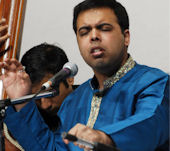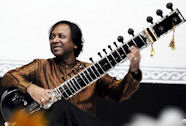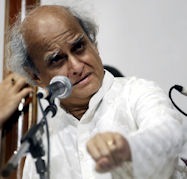ARTICLES
www.artindia.net
does not take any responsibility whatsoever
with regard to articles/ reviews/ previews /information published here.
Any suggestions/ comments /complaints etc. may be sent directly to the writers/ contributors directly.

ITC SRA Sangeet Sammelan
2010 –
A mixed musical bag
by Veejay Sai
Veejay Sai is a well-known award-winning writer, editor and a culture critic. He has written and published extensively on Indian classical music, theatre, food, travel, fashion and performing arts. He loves traveling and researching literary and cultural history. He can be contacted on veejaysai.vs@gmail.com
Veejay
Sai is Indian classical music/dance critic and
Special Correspondent of www.artindia.net
This year’s two-day festival opened on a very pleasant note in the Chowdiah memorial hall in Bangalore. After a brief invocation prayer by Pandit Ajay Chakrabarty, opening the first evening was Bangalore boy Samarth Nagarkar, a vocalist who is also a scholar at the ITC SRA. Samarth took his initial training under Vidushi Aditi Upadhyay, the daughter of Dinakar Kaikini before he went to Mumbai to take further training from Dinakar Kaikini himself. He also received guidance from stalwarts such as Pandit Balasaheb Poonchwale, Pandit S. C. R. Bhat, and Smt. Shashikala Kaikini. He joined the ITC SRA to train under Pandit Ullhas Kashaklar for further study. He is currently a founder-faculty at the K.K.Kapoor sangeet research academy in Lucknow.
 Samarth
is a hard-working boy and this can be seen in his presentation. He opened
with Raag Shree. A slow, haunting and meditative Raag, Shree has been
sung very less on the performance stage in the recent past. He took a
little time to warm up and open his aalaap and Vilambit singing ‘Saanjh
bhayee tum’ , but the end of it he was racing with clear flawless
taans of the Poorvi thaat. His meends were as good as his swara uchcharana
or enunciation. His coupling of komal rishabh and pancham, the vaadi and
samvaadi swaras, one of the signatures of Raag Shree came out well-sung.
His drut composition ‘ Ae ree yu tho aasana de ree’ was a delight
to listen to. A little distracted in his singing, a constant effort to
bring out the best in him, and the awareness that all his gurus sat keenly
listening to him from the front row had Samarth render a fine concert.
He ended his concert with a dadra ‘Morey raja katariya na maaro re’.
While the dadra was good, a phrase which he constantly kept singing was
‘Mann tarapath hain’ instead of ‘tadapath’ which amounts
to suffering. The replacement of ‘Da’ with ‘Rra’ is
more common amongst the Bengal school of vocalists than in others. While
it sounded odd, it wasn’t one bit unpleasant because of his active
involvement. He is a promising vocalist who will surely make a good name
for himself in the coming decade. We need to wait and watch him completely
blossom.
Samarth
is a hard-working boy and this can be seen in his presentation. He opened
with Raag Shree. A slow, haunting and meditative Raag, Shree has been
sung very less on the performance stage in the recent past. He took a
little time to warm up and open his aalaap and Vilambit singing ‘Saanjh
bhayee tum’ , but the end of it he was racing with clear flawless
taans of the Poorvi thaat. His meends were as good as his swara uchcharana
or enunciation. His coupling of komal rishabh and pancham, the vaadi and
samvaadi swaras, one of the signatures of Raag Shree came out well-sung.
His drut composition ‘ Ae ree yu tho aasana de ree’ was a delight
to listen to. A little distracted in his singing, a constant effort to
bring out the best in him, and the awareness that all his gurus sat keenly
listening to him from the front row had Samarth render a fine concert.
He ended his concert with a dadra ‘Morey raja katariya na maaro re’.
While the dadra was good, a phrase which he constantly kept singing was
‘Mann tarapath hain’ instead of ‘tadapath’ which amounts
to suffering. The replacement of ‘Da’ with ‘Rra’ is
more common amongst the Bengal school of vocalists than in others. While
it sounded odd, it wasn’t one bit unpleasant because of his active
involvement. He is a promising vocalist who will surely make a good name
for himself in the coming decade. We need to wait and watch him completely
blossom.
 The
second part of the evening had Ustad Shahid Parvez on sitar accompanied
by pandit Ravindra Yavagal on tabla. If one were to count the likes of
Pandit Ravi Shankar and his generation as the 1st post-colonial premier
league of Indian instrumentalists, Shahid Parvez might be, at the moment,
easily the best sitar players in the world in the current generation.
The torch-bearer of the Etawah or the Imdadkhani gharana of sitar, Shahid
is also one of the most under-rated. It takes a good amount of time and
patience to sit and see his fingering, his technical ability and immense
scholarship when he plays the sitar with such ease.
The
second part of the evening had Ustad Shahid Parvez on sitar accompanied
by pandit Ravindra Yavagal on tabla. If one were to count the likes of
Pandit Ravi Shankar and his generation as the 1st post-colonial premier
league of Indian instrumentalists, Shahid Parvez might be, at the moment,
easily the best sitar players in the world in the current generation.
The torch-bearer of the Etawah or the Imdadkhani gharana of sitar, Shahid
is also one of the most under-rated. It takes a good amount of time and
patience to sit and see his fingering, his technical ability and immense
scholarship when he plays the sitar with such ease.
He opened with Raag Gawati , a delicate raag to deal with on the stage. His slow and seductive Aalap made a progressive advance taking the best out of the gayaaki ang aesthetic and the aggressive tantrakaari indulgence. His layakaari is flawless and it only takes you to sit down with a lot of patience to go through it. Shahid’s sitar is addictive and immersing is style of playing makes you feel like a part of a large canvas he is deliberately painting, layer by layer.
He ended his concert with a dhun in Raag Desh. Once again a popular raag, like a popular savoury, branded and deliver in the Shahid-style, had the audiences asking for more. Was it the magic of the raag or Shahid’s fingers on the Sitar? And Bangalore needed no introduction to the mastery of Pandit Ravindra Yavagal. His fingering on the tabla is not new either to music lovers here. Accompanying Shahid on this concert brought out yet another facet of this versatile tabalchi from Dharwad. For some strange reason there was a man sitting behind Ustadji on the stage with a sad expression on his face, neither playing the tanpura nor giving him any sort of support. He sat there through the concert with a dead-serious face. For some strange reason, it is assumed that classical music must only be dealt with such seriousness and can never be enjoyed. All through the most enjoyable Raag Gauti and its intricacies, this man’s expressions only got sadder and ended up being an unnecessary distraction on the stage. One of the only banes of the program was little children crying in the audience and the regular backstage noise which kept disturbing the Ustad ji.
Organizers must be a little more careful when people bring in children below a certain age and must firmly not allow them. It does not matter to maintain a little discipline to keep the decorum of the concert.
 The
concluding performance for the 1st day of the SRA festival had a wonderful
vocal performance by Pandit Ullhas Kashalkar supported by Pandit Suresh
Talwalkar on the tabla. Ullhas ji is a senior guru at the ITC SRA with a
fair number of students. He opened his concert with Raag Basant Bahaar.
Pandit ji clear taans were accompanied by Talwalkar ji’s signature
style. One must confess at this point that Suresh talwalkar makes a wonderful
dialogue and rapport with his Tabla , unlike many other table players, over
the stretch of the concert, and this becomes very enjoyable once you soak
yourself more into it. Pandit Kashalkar ended his concert with a Bhairavi
composed by the late Ustad Vilayat Khan saab as the day of the concert also
co-incided with his death anniversary. ‘Tum ho jagat ke daata’
almost as close as the good old ‘Yamuna ke teer’ , set to Raag
Bhairavi brought in fond memories of the Ustad’s virtuoso as a composer.
The
concluding performance for the 1st day of the SRA festival had a wonderful
vocal performance by Pandit Ullhas Kashalkar supported by Pandit Suresh
Talwalkar on the tabla. Ullhas ji is a senior guru at the ITC SRA with a
fair number of students. He opened his concert with Raag Basant Bahaar.
Pandit ji clear taans were accompanied by Talwalkar ji’s signature
style. One must confess at this point that Suresh talwalkar makes a wonderful
dialogue and rapport with his Tabla , unlike many other table players, over
the stretch of the concert, and this becomes very enjoyable once you soak
yourself more into it. Pandit Kashalkar ended his concert with a Bhairavi
composed by the late Ustad Vilayat Khan saab as the day of the concert also
co-incided with his death anniversary. ‘Tum ho jagat ke daata’
almost as close as the good old ‘Yamuna ke teer’ , set to Raag
Bhairavi brought in fond memories of the Ustad’s virtuoso as a composer.
The second day of the ITC
SRA festival opened with a felicitation  ceremony
to senior Carnatic violin maestro Dr. Lalgudi Jayaraman. Speaking at the
event was Mr. Anand Rao, the General Manager of ITC Royal Gardenia representing
ITC and Ravi Mathur, the director of ITC SRA. After the brief felicitation
ceremony the evening’s concert opened with Pandit Arun Bahaduri’s
own confessional speech about his love, undying commitment and devotion
to ITC SRA before he started his vocals supported by, a staff member of
the ITC SRA.
ceremony
to senior Carnatic violin maestro Dr. Lalgudi Jayaraman. Speaking at the
event was Mr. Anand Rao, the General Manager of ITC Royal Gardenia representing
ITC and Ravi Mathur, the director of ITC SRA. After the brief felicitation
ceremony the evening’s concert opened with Pandit Arun Bahaduri’s
own confessional speech about his love, undying commitment and devotion
to ITC SRA before he started his vocals supported by, a staff member of
the ITC SRA.
Pandit Bahaduri opened with ‘Koun desh gaye piya mora’ a composition of Sadarang in Raag Multani. While the raag progressed gradually and just about became enjoyable with those wonderful taans and pakads of the Rampur sahaswan gharana style that he was trained in, Panditji managed to mess it up with his bad pronunciation of Sadarang as ‘Shodaarong’ like a blue-blooded Bengali. It might have been a very unconscious slip, but on at such a prestigious concert and a serious audience, such slips cannot be spared. Even in his drut a tired pandit ji kept singing ‘bhayi shyaam avat rain chai andhiyaari’ instead of ‘chayee’. His swaras became increasingly unclear as he added some extra unnecessary shouting to his singing. He continued his concert with ‘Daar daar patta patta’ a composition of Guru Gyan prakash Ghosh in Raag Hindol Bahaar. He ended his concert by stretching it to a badly-rendered Thumri. He sang a Hori ‘Jin maaro pichakari’ in the most unlikely way it should be sung. Hearing him sing the otherwise lively Hori, in a slow, tediously-boring style, one must agree that no one else patronized the Thumri as the Banaras school of musicians did. They remain the last royal rajas of this genre of Hindustani classical music. A restless audience waited for him to finish his concert with the hope that a scholar as senior as him will take the south Indian music lovers more serious and present better another time.
As announced earlier by
Ravi Mathur the head of ITC SRA, their  efforts
to blur the lines between all music genres the next on the stage was a
carnatic vocal concert by none other than the mellifluous Bombay Jayashri.
She opened her concert with ‘Deva Deva Kalayamithe Charanambuja Sevanam’
, a composition of Maharaja Swati Thirunal in Mayamalavagowla Raagam set
to Rupaka taalam. Accompanied by Embar Kannan on the Violin and J.Vaidyanathan
on the Mridangam, Jayashri set the ball rolling fine for the evening.
She continued with a Raagam Tanam Pallavi in Shanmukha priya. After a
wonderfully constructed Aalapam and singing came a brief tani avartanam.
Neither long nor tedious, just enough to keep the energy on the stage
good and high, the RTP resumed like a slow and steady train from station
to station. Jayashri’s voice matures like good wine, concert to concert
and gets addictive. She ended her concert with a Thilana as the eager
crowds sat hungry for more of her music. Embar Kannan’s soulful violin
accompaniment added the extra sweetness to the concert making it a complete
musical experience. Vaidyanathan’s gentle fingering technique on
the Mridangam without over-powering the Kanjira played by Anirudh Athreya
showed his versatility.
efforts
to blur the lines between all music genres the next on the stage was a
carnatic vocal concert by none other than the mellifluous Bombay Jayashri.
She opened her concert with ‘Deva Deva Kalayamithe Charanambuja Sevanam’
, a composition of Maharaja Swati Thirunal in Mayamalavagowla Raagam set
to Rupaka taalam. Accompanied by Embar Kannan on the Violin and J.Vaidyanathan
on the Mridangam, Jayashri set the ball rolling fine for the evening.
She continued with a Raagam Tanam Pallavi in Shanmukha priya. After a
wonderfully constructed Aalapam and singing came a brief tani avartanam.
Neither long nor tedious, just enough to keep the energy on the stage
good and high, the RTP resumed like a slow and steady train from station
to station. Jayashri’s voice matures like good wine, concert to concert
and gets addictive. She ended her concert with a Thilana as the eager
crowds sat hungry for more of her music. Embar Kannan’s soulful violin
accompaniment added the extra sweetness to the concert making it a complete
musical experience. Vaidyanathan’s gentle fingering technique on
the Mridangam without over-powering the Kanjira played by Anirudh Athreya
showed his versatility.
 The
grand finale of the ITC SRA sangeet sammelan had the one and only Pandit
Hariprasad Chaurasia under the spotlight. Panditji is needs no introduction
as a musical genius, but as a person and as an artist, he is the liveliest
on stage. No other artist has the kind of bonhomie rapport Panditji manages
to have with his audience in any concert. He opened his concert with a
wonderful Raag Maru Bihag. Through a short Aalap, Jor and a drut in Madhya
taal, he was accompanied on the Tabla by Pandit Samar Saha of the ITC
SRA, the concert blossomed as Panditji got into his indulgent best. He
continued the concert with a small composition in Raag Hamsadhwani and
ended it with Raag Pahadi, amidst shouts from the audiences who wanted
more.
The
grand finale of the ITC SRA sangeet sammelan had the one and only Pandit
Hariprasad Chaurasia under the spotlight. Panditji is needs no introduction
as a musical genius, but as a person and as an artist, he is the liveliest
on stage. No other artist has the kind of bonhomie rapport Panditji manages
to have with his audience in any concert. He opened his concert with a
wonderful Raag Maru Bihag. Through a short Aalap, Jor and a drut in Madhya
taal, he was accompanied on the Tabla by Pandit Samar Saha of the ITC
SRA, the concert blossomed as Panditji got into his indulgent best. He
continued the concert with a small composition in Raag Hamsadhwani and
ended it with Raag Pahadi, amidst shouts from the audiences who wanted
more.
The two day ITC SRA Sangeet Sammelan was a mixed musical bag and a wholesome experience for music lovers in Bangalore. We hope they do more such festivals in a year and keep up the wonderful service they are doing for the cause of music at the ITC SRA.
© Art India Net. ® 1998--2007. We welcome your suggestions and comments to improve this site. Please post an e-mail to add information.
Founder/ Content Editor/ Site Construction/ Maintenance: GS Rajan, Technical Advisor: Sudhir Gandotra Hosted by Communicators - Indserve Infotech P Ltd. © ®